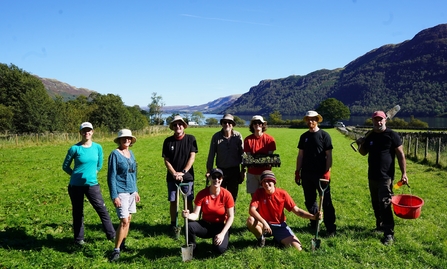
Volunteers ready for plug-planting at Glencoyne near Penrith, part of Coast to Fell, a Network for Nature-funded project © Cumbria Wildlife Trust
Join by 30 January to get 3 months free membership!

Volunteers ready for plug-planting at Glencoyne near Penrith, part of Coast to Fell, a Network for Nature-funded project © Cumbria Wildlife Trust
The recent September sunshine brought volunteers out in good numbers to help us plant wildflower plug plants at Glencoyne, near Penrith. By the end of the two days, the hard-working planters had put in an amazing 2,825 plants, and were quite rosy-cheeked, working all day out in the warm September sun.
Thanks to the volunteers, next year the site will be awash with oxeye daisies, meadow cranesbill, great burnet, autumn hawkbit and many other wildflowers. It will be transformed into a haven for pollinating insects, giving them more opportunities to forage, and joining up important habitats that are currently fragmented.
These two days on National Trust land at Glencoyne were the last planting events for Coast to Fell, a joint project with National Highways, in which 16 grassland sites across Cumbria are being transformed, to benefit people, nature and wildlife. A total of 19,800 plugs have been planted during this season, in 16 fields across eight sites in Cumbria. The sites range from small farms of just under an acre, to larger areas of land within the Arnside and Silverdale National Landscape (formerly known as AONB) or owned by the National Trust.
Shannon Horrocks, Grassland Conservation Office for Cumbria Wildlife Trust said: “The weather was fantastic for our final days planting of the year, at Glencoyne. I’m really chuffed with all the planting events we’ve held. Lots of wonderful volunteers have joined us and it’s been a fantastic effort from our contractors who have helped deliver the planting at these sites – a huge thank you to them all, and the National Trust staff who helped too.
“There’s an amazing variety of wild pollinators in Cumbria, including bumblebees, hoverflies, solitary bees, butterflies and moths. But they depend on flower-rich habitat to survive and the loss of this precious habitat, mainly through changes in farming practices, has led to their decline.
“Our vision for the future of these hay meadows is that by working with landowners, we can change management practices over the long term, join up fragmented places that can support a wealth of wildlife and provide amazing places for people to enjoy.”
Coast to Fell (which ends in March 2025) is part of Network for Nature, an £11.5 million programme managed by the Royal Society for Wildlife Trusts and funded through National Highways’ Environment and Wellbeing Designated Funds programme.
Network for Nature is an £11.5 million programme managed by the Royal Society for Wildlife Trusts and funded through National Highways’ Environment and Wellbeing Designated Funds programme.
Over four years, 20 Wildlife Trusts in England have been working on a huge range of projects from chalk downlands to boost rare butterflies, to creating and restoring wetlands, and conserving rare chalk streams for endangered water voles. Some Trusts are using natural solutions, like reedbeds and ponds to help filter polluted road run-off and stop it going into rivers or nature reserves. Overall, 39 biodiversity projects will enhance, restore and create more than 2,957 acres (1,197 hectares) of woodlands, grasslands, peatlands and wetlands across every region of England.
National Highways is the company responsible for England’s motorways and major A-roads. National Highways’ Designated Funds programme is divided into four funding streams: environment and wellbeing, users and communities, safety and congestion and innovation and modernisation.